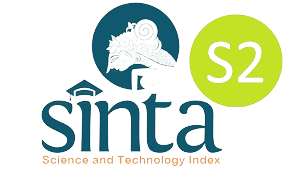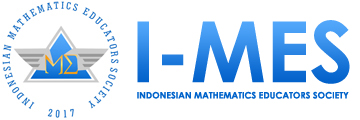Uncovering mathematical activities and concepts in Batik Pendekar of Madiun City through the lens of ethnomathematics
DOI:
https://doi.org/10.29408/jel.v11i3.29982Keywords:
Batik Pendekar, ethnomathematics, mathematical activities, mathematical conceptsAbstract
Despite the growing recognition of ethnomathematics as a bridge between culture and formal mathematics education, limited research has explored the mathematical knowledge embedded in regional cultural artifacts such as Batik Pendekar from Madiun City, Indonesia. This study aims to uncover the mathematical activities, concepts, and anthropological aspects inherent in the Batik Pendekar tradition to support culturally responsive mathematics education. This research employed a qualitative ethnographic approach. This research was conducted at the Batik Murni Madiun City Gallery by collecting data through observation, interviews, and documentation. The data were analysed qualitatively using triangulation methods. The findings reveal that artisans engage in meaningful mathematical practices, such as measuring fabric dimensions, counting dye usage and production costs, and designing motifs based on geometric principles. The mathematical concepts embedded in Batik Pendekar include geometry, triangular shapes, and transformation geometry (translation and reflection). Additionally, anthropological aspects, such as local wisdom, social values, and symbolic meanings, are integral to these activities. The study concludes that Batik Pendekar serves as a rich ethnomathematical resource, offering opportunities to bridge mathematics learning with local culture and enhance contextual understanding in mathematics education.
References
Abdullah, R., & Ismail, Z. (2010). Silat: The martial art of Malaysia. Asian Culture and History, 2(2), 123–131. https://doi.org/10.5539/ach.v2n2p123
Agasi, G. R., & Wahyuono, Y. D. (2019). Eksplorasi etnomatematika pada motif batik Troso Jepara sebagai bahan ajar matematika [Exploration of ethnomathematics in Troso Jepara batik motifs as mathematics teaching materials]. Jurnal Pedagogi dan Pembelajaran, 2(2), 151–160. https://doi.org/10.26740/jrpd.v7n2.p98-104
Astriandini, M. G., & Kristanto, Y. D. (2021). Kajian etnomatematika pola batik keraton Surakarta melalui analisis simetri [Ethnomathematical study of Surakarta palace batik patterns through symmetry analysis]. Mosharafa: Jurnal Pendidikan Matematika, 10(1), 13–24. https://doi.org/10.31980/mosharafa.v10i1.637
Bishop, A. (1997). Educating the mathematical enculturators (Paper presented at ICMI- China Regional Conference, Shanghai, China, August 1994). Papua New Guinea Journal of Teacher Education, 4(2), 17–20.
Civil, M. (2010). Culture and mathematics: A community approach. Journal of Intercultural Studies, 23(2), 133–148. https://doi.org/10.1080/07256860220151050A
D’Ambrosio, U. (2001). What is ethnomathematics, and how can it help children in schools? Teaching Children Mathematics, 7(6), 308–310. http://www.jstor.org/stable/41199887
D’Ambrosio, U. (2004). Peace, social justice, and ethnomathematics. In The Montana Mathematics Enthusiast, Monograph 1.
D’Ambrosio, U. (2006). Ethnomathematics: Link between traditions and modernity. Sense Publishers.
D’Ambrosio, U. (2006). The program ethnomathematics: A theoretical basis of the dynamics of intra-cultural and intercultural encounters. The Montana Mathematics Enthusiast, 3(2), 1–16.
d’Entremont, Y. (2015). Linking mathematics, culture and community. Procedia - Social and Behavioral Sciences, 174(1999), 2818–2824. https://doi.org/10.1016/j.sbspro.2015.01.973
Effendy, T. (2017). Pencak silat: Budaya, olahraga dan bela diri [Pencak Silat: Culture, Sport and Self-Defense]. Raja Grafindo Persada.
Fajarsari, A. P., Krisdiana, I., & Masfingatin, T. (2022). Pengembangan modul ajar berbasis etnomatematika pada materi lingkaran untuk meningkatkan hasil belajar siswa kelas VIII SMP Negeri 2 Geger [Development of ethnomathematics-based teaching modules on circle material to improve learning outcomes of class VIII students at SMP Negeri 2 Geger]. Seminar Nasional Matematika, Geometri, Statistika, dan Komputasi, 434–440.
Gembong, S., Krisdiana, I., Suprapto, E., Setyansah, R. K., Widodo, S. A., & Murtafiah, W. (2022). The effectiveness of mathematics learning based on Javanese vegetable salad context to improving students’ higher order thinking skills. Pegem Egitim ve Ogretim Dergisi, 13(1), 84–91. https://doi.org/10.47750/pegegog.13.01.10
Harahap, A., & Mujib, M. (2020). Penggunaan motif batik Medan dalam pembelajaran geometri [The use of Medan batik motifs in geometry learning]. Jurnal Pendidikan Matematika, 8(3), 123–134.
Harahap, L., & Mujib, A. (2022). Eksplorasi etnomatematika pada motif batik Medan [Exploration of ethnomathematics in Medan batik motifs]. Journal Ability: Journal of Education and Social Analysis, 3(2), 61–72. https://doi.org/10.51178/jesa.v3i2.520
Irawan, A., Lestari, M., & Rahayu, W. (2022). Konsep etnomatematika batik tradisional Jawa sebagai pengembangan media pembelajaran matematika [The concept of ethnomathematics of traditional Javanese batik as a development of mathematics learning media]. Scholaria: Jurnal Pendidikan dan Kebudayaan, 12(1), 39–45. https://doi.org/10.24246/j.js.2022.v12.i1.p39-45
Maskar, S., Anderha, R. R., & Indonesia, U. T. (2019). Pembelajaran transformasi geometri dengan pendekatan motif kain tapis Lampung [Learning geometric transformation with the Lampung tapis cloth motif approach]. Mathema Journal, 1(1), 40–47.
Masruroh, M., Murtafiah, W., & Setyansah, R. K. (2025). Exploration of mathematics concepts through ethnomathematic activities on rice farmers in Kaliabu village as a learning resource. In AIP Conference Proceedings, 3038(1). https://doi.org/10.1063/5.0254380
Meaney, T., Trinick, T., & Fairhall, U. (2017). Language choice and ethnomathematics in the pacific: Transforming education? Journal of Mathematics and Culture, 11(3), 112–132.
Meland, E. A., & Brion-Meisels, G. (2024). An integrative model for culturally sustaining SEL in the classroom. Social and Emotional Learning: Research, Practice, and Policy, 3(April), 100042. https://doi.org/10.1016/j.sel.2024.100042
Miles, M., Huberman, M., & Saldana, J. (2014). Qualitative data analysis: A method sourcebook. In SAGE. https://doi.org/10.1080/0140528790010406
Mulyati, S., & Evendi, H. (2020). Pembelajaran Matematika melalui Media Game Quizizz untuk Meningkatkan Hasil Belajar Matematika SMP [Mathematics Learning through Quizizz Game Media to Improve Middle School Mathematics Learning Outcomes]. GAUSS: Jurnal Pendidikan Matematika, 3(1), 64–73. https://doi.org/10.30656/gauss.v3i1.2127
Murtafiah, W., Lukitasari, M., & Lestari, N. D. S. (2021). Exploring the decision-making process of pre-service teachers in solving mathematics literacy problems. Jurnal Pendidikan Matematika, 15(2), 145–160. https://doi.org/10.22342/jpm.15.2.13908.145-160
Murtafiah, W., Wardani, Y. N., Darmadi, D., & Widodo, S. A. (2024). Profile of open-start problem-solving with context Sarangan Lake viewed students’ learning styles in junior high school. Journal of Education and Learning, 18(2), 448–461. https://doi.org/10.11591/edulearn.v18i2.21051
Nursyeli, F., & Puspitasari, N. (2021). Studi etnomatematika pada Candi Cangkuang Leles Garut Jawa Barat [Ethnomathematics study at Cangkuang Leles Temple, Garut, West Java]. Plusminus: Jurnal Pendidikan Matematika, 1(2), 327–338.
Pilkhwal, S., & Manral, B. (2023). Role of education and culture in individual, social, and national development. Journal of Advanced Education and Sciences, 3(2), 41–43.
Powell, A. B., & Frankenstein, M. (1997). Ethnomathematics: challenging eurocentrism in mathematics education. The Journal of Negro Education, 66(4), 283–295.
Pradana, A., & Setyawan, S. (2019). Batik dan matematika: Sebuah pendekatan etnomatematika dalam pembelajaran geometri [Batik and mathematics: An ethnomathematics approach to geometry learning]. Jurnal Pendidikan dan Kebudayaan, 12(4), 110–118.
Prahmana, R. C. I. (2022). Ethno-realistic mathematics education: The promising learning approach in the city of culture. SN Social Sciences, 2(12). https://doi.org/10.1007/s43545-022-00571-w
Prahmana, R. C. I., & D’Ambrosio, U. (2020). Learning geometry and values from patterns: Ethnomathematics on the batik patterns of Yogyakarta, Indonesia. Journal on Mathematics Education, 11(3), 439–456. https://doi.org/10.22342/jme.11.3.12949.439-456
Pratama, R. A., & Yelken, T. Y. (2024). Effectiveness of ethnomathematics-based learning on students’ mathematical literacy: a meta-analysis study. Discover Education, 3(1). https://doi.org/10.1007/s44217-024-00309-1
Rahmawati, N. I. A., & Soebagyo, J. (2022). Implementation of android-based learning media with ethnomathematical approach batik nusantara. Budapest International Research and Critics Institute-Journal, 5(3), 25177–25184.
Rakhmawati, R. (2016). Aktivitas matematika berbasis budaya pada masyarakat Lampung [Culturally based mathematics activities in Lampung society]. Al-Jabar: Jurnal Pendidikan Matematika, 7(2), 221–230.
Riyanti, D. E., Sari, R. K., & Saltifa, P. (2022). Eksplorasi pada kain besurek provinsi Bengkulu (Kajian Etnomatematika) [Exploration of Bengkulu province Besurek fabric (ethnomathematical studies)]. Jurnal Equation: Teori dan Penelitian Pendidikan Matematika, 5(September), 85–96.
Riyanti, M., & Syafri, R. (2020). Etnomatematika kain besurek sebagai media pembelajaran geometri transformasi [Ethnomathematics of besurek cloth as a learning medium for transformation geometry]. Jurnal Pendidikan Matematika, 9(2), 112–120.
Rosa, M., & Orey, D. (2011). Ethnomathematics: the cultural aspects of mathematics. Revista Latinoamericana de Etnomatemática, 4(2), 32–54. http://www.revista.etnomatematica.org/index.php/RLE/article/view/32
Rosa, M., & Orey, D. C. (2021). Ethnomathematics and the pedagogical action of cultural context. Journal of Mathematics and Culture, 15(1), 5–20.
Rudolf, R., & Sari, R. R. (2020). Etnomatematika dalam motif batik tradisional sebagai media pembelajaran matematika berbasis budaya [Ethnomathematics in traditional batik motifs as a culture-based mathematics learning medium]. Jurnal Pendidikan Matematika Indonesia, 5(1), 1–10. https://doi.org/10.26737/jpmi.v5i1.1090
Setyaningrum, R., & Fadli, M. R. (2022). Pecel sebagai ekspresi budaya lokal dalam konstruksi identitas masyarakat Madiun [Pecel as an expression of local culture in the construction of Madiun community identity]. Jurnal Kajian Budaya, 10(1), 22–34. https://doi.org/10.1234/jkb.v10i1.2022
Setyo, A. A., & Ba’diah, A. S. (2021). Transformasi geometri: Teori, aplikasi & pemanfaatan teknologi [Geometric transformations: Theory, applications and utilization of technology]. Yudha English Gallery.
Soebandono, S. (2021). Makna dan filosofi motif batik truntum dalam budaya Jawa [The meaning and philosophy of the truntum batik motif in culture]. Jurnal Desain Dan Budaya Visual, 4(2), 112–124. https://doi.org/10.31294/jdbv.v4i2.12345
Sriraman, B. (2007). Is mathematical creativity a domain-specific or domain-general construct? Mathematics Thinking and Learning, 9(1), 1–34.
Sunzuma, G., & Maharaj, A. (2019). Teacher-related challenges affecting the integration of ethnomathematics approaches into the teaching of geometry. Eurasia Journal of Mathematics, Science and Technology Education, 15(9). https://doi.org/10.29333/ejmste/108457
Surur, M., Oktavia, S. T., Prodi, D., Ekonomi, P., Prodi, M., & Ekonomi, P. (2019). Pengaruh model pembelajaran discovery learning [The influence of the discovery learning learning model]. Jurnal Pendidikan Edutama, 6(1), 11–18.
Suryana, Y., & Hidayah, N. (2020). Etnomatematika batik: Membawa budaya lokal dalam pembelajaran geometri [Batik ethnomathematics: Bringing local culture into geometry learning]. Jurnal Pendidikan dan Pembelajaran Matematika, 5(2), 58–66.
Syafril, & Zen, Z. (2019). Dasar-dasar ilmu pendidikan [Basics of educational science]. Prenada Media.
Ulum, B. (2018). Etnomatematika Pasuruan: Eksplorasi geometri untuk sekolah dasar pada motif batik Pasedahan Suropati [Pasuruan Ethnomathematics: Geometry exploration for elementary school on Pasedahan Suropati batik motifs]. Jurnal Review Pendidikan Dasar : Jurnal Kajian Pendidikan dan Hasil Penelitian, 4(2), 686–696. https://doi.org/10.26740/jrpd.v4n2.p686-696
UNESCO. (2019). Learning to live together sustainably: Education for sustainable development (ESD). UNESCO Publishing.
Waril, D., & Musa, S. (2022). Eksplorasi etnomatematika dan etnosains (etnomathsains) pada batik bomba [Exploration of ethnomathematics and ethnoscience (ethnomathscience) on bomba batik]. Koordinat Jurnal MIPA, 3(1), 33–38.
Wibowo, T. (2021). Kuliner tradisional Jawa dalam konteks identitas budaya dan pariwisata lokal [Traditional Javanese cuisine in the context of local cultural identity and tourism]. Jurnal Gastronomi dan Pariwisata, 5(2), 75–86. https://doi.org/10.7454/gastropariwisata.v5i2.1089
Wulandari, D., & Suryadi, D. (2021). Eksplorasi etnomatematika pada praktik membatik di Malang sebagai sumber belajar matematika [Exploration of ethnomathematics in batik practice in Malang as a source of learning mathematics]. Jurnal Pendidikan Matematika dan Sains, 9(1), 50–58.
Yolanda, F. O., & Putra, A. (2022). Eksplorasi etnomatematika pada motif batik sebagai sumber belajar matematika [Exploration of ethnomathematics in batik motifs as a source of learning mathematics]. Prima Magistra: Jurnal Ilmiah Kependidikan, 3(2), 188–195.
Zhu, C., & Wu, X. (2023). A study on differential effects of mathematics reading ability on students’ value-added mathematics achievements. Behavioral Sciences, 13(9), 1–17. https://doi.org/10.3390/bs13090754
Downloads
Published
How to Cite
Issue
Section
License
Copyright (c) 2025 Ika Krisdiana, Titin Masfingatin, Wasilatul Murtaifiah, Febriana Nor Fadhilla, Gerald DG. Mabuti

This work is licensed under a Creative Commons Attribution-ShareAlike 4.0 International License.
Authors who publish with the Jurnal Elemen agree to the following terms:
- Authors retain copyright and grant the journal right of first publication with the work simultaneously licensed under Creative Commons Attribution-ShareAlike 4.0 International License (CC BY-SA 4.0).
- Authors are able to enter into separate, additional contractual arrangements for the distribution of the journal's published version of the work (e.g., post it to an institutional repository or publish it in a book), with an acknowledgment of its initial publication in this journal.
- Authors are permitted and encouraged to post their work online (e.g., in institutional repositories or on their website) prior to and during the submission process, as it can lead to productive exchanges, as well as earlier and greater citation of published work.
Jurnal Elemen is licensed under a Creative Commons Attribution-ShareAlike 4.0 International License





